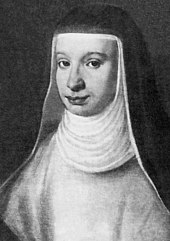Early life
Galileo was born in Pisa (then part of the Duchy of Florence), Italy, in 1564,[15] the first of six children of Vincenzo Galilei, a famous lutenist, composer, and music theorist, and Giulia Ammannati. Galileo became an accomplished lutenist himself and would have learned early from his father a healthy scepticism for established authority,[16] the value of well-measured or quantified experimentation, an appreciation for a periodic or musical measure of time or rhythm, as well as the illuminative progeny to expect from a marriage of mathematics and experiment. Three of Galileo's five siblings survived infancy. The youngest, Michelangelo (orMichelagnolo), also became a noted lutenist and composer although he contributed to financial burdens during Galileo's young adulthood. Michelangelo was unable to contribute his fair share of their father's promised dowries to their brothers-in-law, who would later attempt to seek legal remedies for payments due. Michelangelo would also occasionally have to borrow funds from Galileo to support his musical endeavours and excursions. These financial burdens may have contributed to Galileo's early fire to develop inventions that would bring him additional income.
Galileo was named after an ancestor, Galileo Bonaiuti, a physician, university teacher and politician who lived in Florence from 1370 to 1450; at that time in the late 14th century, the family's surname shifted from Bonaiuti (or Buonaiuti) to Galilei. Galileo Bonaiuti was buried in the same church, the Basilica of Santa Croce in Florence, where about 200 years later his more famous descendant Galileo Galilei was also buried. When Galileo Galilei was eight, his family moved to Florence, but he was left with Jacopo Borghini for two years.[15] He then was educated in the Camaldolese Monastery at Vallombrosa, 35 km southeast of Florence.[15]
Although a genuinely pious Roman Catholic,[17] Galileo fathered three children out of wedlock with Marina Gamba. They had two daughters, Virginia in 1600 and Livia in 1601, and one son, Vincenzo, in 1606.[18] Because of their illegitimate birth, their father considered the girls unmarriageable, if not posing problems of prohibitively expensive support or dowries, which would have been similar to Galileo's previous extensive financial problems with two of his sisters.[19] Their only worthy alternative was the religious life. Both girls were accepted by the convent of San Matteo in Arcetri and remained there for the rest of their lives.[20] Virginia took the name Maria Celeste upon entering the convent. She died on 2 April 1634, and is buried with Galileo at the Basilica of Santa Croce, Florence. Livia took the name Sister Arcangela and was ill for most of her life. Vincenzo was later legitimised as the legal heir of Galileo and married Sestilia Bocchineri.[21]
Career as a scientist
Although Galileo seriously considered the priesthood as a young man, at his father's urging he instead enrolled at the University of Pisa for a medical degree.[22] In 1581, when he was studying medicine, he noticed a swingingchandelier, which air currents shifted about to swing in larger and smaller arcs. To him it seemed, by comparison with his heartbeat, that the chandelier took the same amount of time to swing back and forth, no matter how far it was swinging. When he returned home, he set up two pendulums of equal length and swung one with a large sweep and the other with a small sweep and found that they kept time together. It was not until Christiaan Huygens almost one hundred years later that the tautochrone nature of a swinging pendulum was used to create an accurate timepiece.[23] Up to this point, Galileo had deliberately been kept away from mathematics, since a physician earned a higher income than a mathematician. However, after accidentally attending a lecture on geometry, he talked his reluctant father into letting him study mathematics and natural philosophy instead of medicine.[23] He created a thermoscope, a forerunner of the thermometer, and in 1586 published a small book on the design of a hydrostatic balance he had invented (which first brought him to the attention of the scholarly world). Galileo also studied disegno, a term encompassing fine art, and in 1588 obtained the position of instructor in the Accademia delle Arti del Disegno in Florence, teaching perspective and chiaroscuro. Being inspired by the artistic tradition of the city and the works of the Renaissance artists, Galileo acquired an aesthetic mentality. While a young teacher at the Accademia, he began a lifelong friendship with the Florentine painter Cigoli, who included Galileo's lunar observations in one of his paintings.[24][25]
In 1589, he was appointed to the chair of mathematics in Pisa. In 1591, his father died, and he was entrusted with the care of his younger brother Michelagnolo. In 1592, he moved to the University of Padua where he taught geometry,mechanics, and astronomy until 1610.[26] During this period, Galileo made significant discoveries in both pure fundamental science (for example, kinematics of motion and astronomy) as well as practical applied science (for example, strength of materials and improvement of the telescope). His multiple interests included the study of astrology, which at the time was a discipline tied to the studies of mathematics and astronomy.[27]

No comments:
Post a Comment